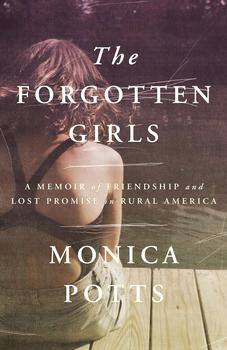Summary | Excerpt | Reviews | Beyond the Book | Readalikes | Genres & Themes | Author Bio

A Memoir of Friendship and Lost Promise in Rural America
by Monica Potts
Darci and James had met only weeks before. Before staying at his place, I'd later learn, she'd had no income and had been homeless. Was her need for shelter the reason for the relationship? I would ask her later, and she said no. But in the past, when she'd needed places to stay, or money, or security, she'd always relied on relationships with men. This was my first view into how unstable her life had become.
"I'm sorry if I smell like alcohol," she said shakily from the passenger seat, as we buckled up. "My throat was hurting so bad... . These are some of the best people." She indicated the trailer through the windshield. "They'll do anything nice for me, but they're stern."
I was distracted backing out of the yard and dodging the dogs, so I didn't ask what she meant by stern. Most of her conversation, as we drove away, was incoherent rambling that went nowhere except unrelated tendrils of conversation.
"How do you know James?" I asked.
"That's where it gets crazy is right there with James," she said. "Oh my gosh, Monica, you wouldn't believe the things that go on in these hills. I look around, and I'm like, 'Is this really happening?' "
* * *
When Darci contacted me out of the blue, I knew only that our lives had gone in radically different directions. I had become a journalist, and I'd been returning to my hometown in the mountains to investigate a disturbing trend. A team of University of Illinois Chicago population health experts led by Jay Olshansky (in a study published in Health Affairs in August 2012) had found that white women who did not graduate from high school were dying five years younger than such women had a generation before. For their male counterparts, it was three years.
Study after study over the next decade supported that initial overall finding: the least educated white Americans were dying younger than they had in the previous generation. Such a rapid drop in life expectancy almost never happens absent war, an earth-shattering political revolution, or a global pandemic. Two of these things would come later: the political upheaval manifested in Donald Trump's election and augmented by his tenure president, and the devastation wrought by Covid-19 in 2020. But the drop began before those events.
That the decline was among white Americans surprised everyone, including me. Black Americans in general have higher rates of mortality than whites at every age, as a result of systemic racism, prejudice, and uneven medical care. But the racial gap in mortality had been targeted for change, and it had been closing, albeit too slowly, so that at least before the Covid-19 pandemic hit, Black Americans were living longer. But even as the racial gap closed, the drop in life expectancy among white Americans showed that the education gap was widening.
From 2014 to 2017, the decline in life expectancy among the least educated white Americans, women in particular, was the longest and most sustained in a hundred years, according to the Journal of the American Medical Association. In 2015 Anne Case and Angus Deaton, economists at Princeton University, found that the drop in life expectancy, especially for middle-aged whites, was largely attributable to increases in drug overdoses, suicides, and complications from alcoholism, a trio of ailments they called "deaths of despair." As Case and Deaton continued their work in the following years, they found these deaths were equally distributed between white men and women in this group; they discounted deaths from smoking, a habit that had persisted for the least educated white women even as it had decreased for other groups.
Diseases of despair weren't the only reason these women were dying. In 2018 two economists at Dartmouth College, Paul Novosad and Charlie Rafkin, found that deaths from all causes, not just deaths of despair, were rising among the least educated whites. "The least educated middle aged white women, in particular, are now at higher risk of dying from cancer, heart diseases and respiratory diseases, among other causes, even as mortality from these causes has declined sharply for those outside of the bottom 10 percent," they wrote.* This group seemed to be suffering from a range of disadvantages, and the complexity of the issues made it difficult for researchers to identify a specific cause for this trend. "It's hard to point out this one specific variable that's driven this increase in mortality," Rafkin told me. "It's that there's this general malaise."
From the book The Forgotten Girls: A Memoir of Friendship and Lost Promise in Rural America by Monica Potts. Copyright © 2023 by Monica Potts. Published by Random House, an imprint and division of Penguin Random House LLC. All rights reserved.




Experience is not what happens to you; it's what you do with what happens to you
Click Here to find out who said this, as well as discovering other famous literary quotes!
Your guide toexceptional books
BookBrowse seeks out and recommends the best in contemporary fiction and nonfiction—books that not only engage and entertain but also deepen our understanding of ourselves and the world around us.